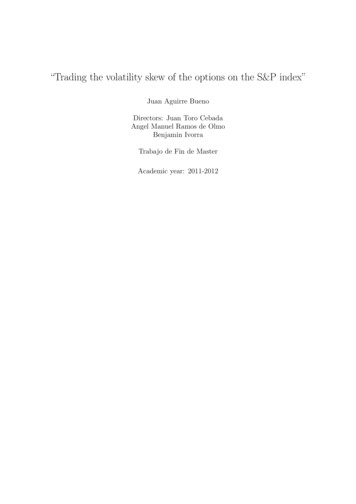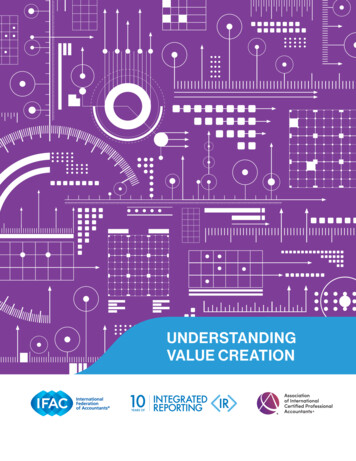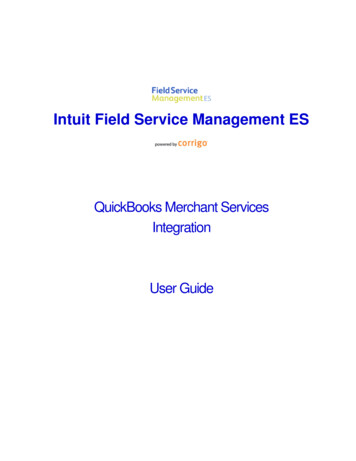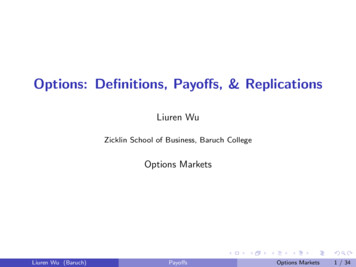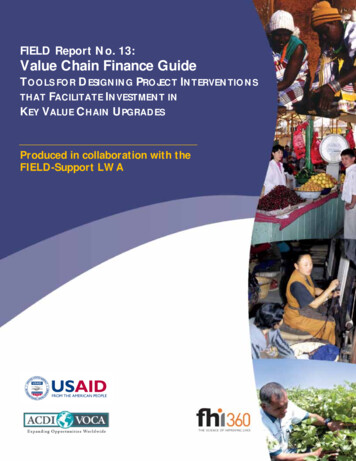
Transcription
FIELD Report No. 13:Value Chain Finance GuideTOOLS FOR DESIGNING PROJECT INTERVENTIONSTHAT FACILITATE INVESTMENT INKEY VALUE CHAIN UPGRADESProduced in collaboration with theFIELD-Support LWA
FIELD Report No. 13:Value Chain Finance GuideTools for Designing Project Interventionsthat Facilitate Investment inKey Value Chain UpgradesJuly 2012This publication was prepared by Robert Fries, Geoffrey Chalmers, and Dun Grover ofACDI/VOCA through the FHI 360-managed FIELD-Support LWA. Find out more about FIELDSupport LWA at www.microlinks.org/field-support.This study was made possible with the generous support of the American people through theUnited States Agency for International Development (USAID). The contents are the responsibilityof the authors and do not necessarily reflect the views of FHI 360, USAID, or the United StatesGovernment.
Table of ContentsIntroduction . 2Tools at a Glance. 3Value Chain Analysis Tools . 4Tool 1: Value Chain Brainstorming Worksheet . 4Example of Use – Tajikistan . 5Tool 2: Value Chain Strategy Framework . 6Example of Use – Tajikistan . 7Reference 1: Financial Product Taxonomy . 8Financial Gaps and Actors Tools . 14Note On The Need To Aggregate Value Chains: . 14Tool 3: Incentives and Constraints Matrix . 18Example of Use – Jamaica . 18Tool 4: Incentives Ranking Tool . 20Example of Use – Jamaica . 20Reference 2: Bridging Gaps Quick Guide . 21Bridging the Gaps Tools . 23Tool 5: Work Planning Guide . 23Tool 6: Engaging Stakeholders Chart . 25Annexes . 27Tool 1 Worksheet. 27Tool 2 Worksheet. 28Tool 3 Worksheet. 29Tool 4 Worksheet. 30Tool 5 Worksheet. 31Tool 6 Worksheet. 32List of FiguresFigure 1. Value Chain Finance Guide: Framework and Methodology . 3Figure 2 Reference Guides: Financial Product Taxonomy and Bridging the Gap Quick Guide. 3Figure 3. Value Chain Brainstorming Worksheet . 4Figure 4. Value Chain Brainstorming Worksheet – Example from Tajikistan. 5Figure 5. Value Chain Strategy Framework . 7Figure 6. Value Chain Strategy Framework – Example from Tajikistan . 8Figure 7. Demands for Financial Services of Farms and Other Small Enterprises . 9Figure 8. Instruments for Financing Businesses . 12Figure 9. Incentives and Constrains Matrix . 18Figure 10. Incentives and Constrains Matrix – Use in Jamaica . 19Figure 11. Incentives Ranking Tool . 20Figure 12. Incentives Ranking Tool – Example from Jamaica . 21Figure 13. Bridging Gaps Quick Guide . 21Figure 14. Work Planning Guide . 23Figure 15. Work Planning Guide – An Example . 24Figure 16. Engaging Stakeholders Chart . 25Figure 17. Engaging Stakeholders Chart – An Example . 26
IntroductionThis guide is intended to provide tools and references to help practitioners—people who design,implement and support value chain development and agricultural finance programs—assess the financialproducts, strategic alliances and methodologies that can facilitate financing for investment in value chains.The approach builds on the value chain analytical framework to identify and prioritize specific upgradesthat enable value chain actors to benefit from market opportunities, and then focus on the financing thatis required to achieve those upgrades. The objective is not to expand financial services as an end in itself,but to expand those financial services most critical to the growth and competitiveness of selected valuechains. The activities in this guide assume that value chains have already been selected and analyzed, andthat their most promising market opportunities have been identified.In value chain finance, actors within the value chain can play a direct role in financing other actors and/oran indirect role in facilitating loans from financial institutions by lowering transaction costs andrepayment risks. There are many resources and publications on value chain finance and countlessvarieties of financial arrangements and mechanisms that may constitute “value chain finance.” However,a key challenge for practitioners is to identify the arrangements and mechanisms that are mostappropriate for a specific market context and that will generate the greatest impact on thecompetitiveness of targeted value chains. This guide is intended to support a facilitative approach andprovide a framework for discussions with stakeholders about ways of addressing common challenges.The tools in this guide can be used to prompt questions that lead to a better understanding of actors’incentives and constraints and the potential roles they may play in bridging financial gaps. The value ofthe guide is largely tied to the ability of the practitioner to engage in a collaborative process withstakeholders through these exercises; it is important to recognize that it is not necessary to use everytool or fill in every blank but rather consider the key questions each exercise asks and understand howthey pertain to the particular financial opportunity at hand. The tools are organized in three chapterswhich are outlined below.1. Value Chain Analysis to determine which upgrades and investments in value chains willimprove competitiveness. Tools help the user think through what changes are needed to makecritical upgrades, and which of these changes require a financial investment.2. Financial Gaps and Actors to identify stakeholders who can deliver financial products andservices to facilitate identified investments. Tools and resources help the user evaluate theincentives and constraints of value chain actors and financial institutions.3. Bridging Financial Gaps to design activities that help facilitate the development andexpansion of these products and services. Tools help practitioners plan resources aroundstrategic interventions that build the long-term capacity of the value chain to respond to itsinvestment needs.These three steps reflect a market systems approach to development interventions. The frameworkmethodology asserts that purposeful, facilitative interventions can help stakeholders bridge gaps andinvest in upgrades that will help them pursue promising market opportunities that lead to increasedvalue chain competitiveness. As Figure 1 below illustrates, analysis should start with strategic marketopportunities. These opportunities then focus attention on the most relevant upgrades, constraints andproject interventions. Our experience shows that analysis that begins with constraints, financial productsor interventions can produce plans that are less strategic, less focused and less effective.FIELD Report No. 13: Value Chain Finance Guide Tools for Key Value Chain Upgrades2
Figure 1. Value Chain Finance Guide: Framework and MethodologyTools at a GlanceAs the graphic below illustrates, each phase of analysis has two templates that can be filled in to helpproject staff and stakeholders understand and articulate the critical market opportunities that are beingpursued, the gaps in financial service delivery that are being addressed, and the roles and activities ofproject team members and other stakeholders. In addition to these templates, we have included tworeference guides, one that maps out a range of financial products and services and one that identifiescommon gaps. These reference guides are designed to help in the application of such tools as the“Value Chain Strategy Framework,” the “Incentives and Constraints Table,” and the “WorkplanningGuide.”Figure 2 Reference Guides: Financial Product Taxonomy and Bridging the Gap Quick GuideVC Analysis ToolsFinancial Gaps & Actors ToolsBridging the Gap Tools1. Brain-storming Worksheet3. Incentives & Constraints Table5. Work-planning Guide2. Value Chain Strategy Framework4. Incentives Ranking Graph6. Engaging Stakeholders ChartFIELD Report No. 13: Value Chain Finance Guide Tools for Key Value Chain Upgrades3
Value Chain Analysis ToolsThis first section provides tools to identify financing demands within a value chain. It is important toconduct assessments of value chains 1 prior to using these tools. A thorough assessment of the targetedvalue chain will provide answers to the fundamental questions posed in this section, in which case it maybe possible to skip to the next. However, lessons learned through field testing have shown that thesetools are useful for consolidating, organizing and articulating complex analysis into a clear strategy.Tool 1: Value Chain Brainstorming WorksheetThe brainstorming worksheet provides a template for consolidating information from a broader valuechain assessment and focusing in on investments that are critical to competitiveness. The tool starts withthe market opportunity, which provides context for determining which upgrades are linked to higherreturns. This helps to narrow the universe of upgrades to those that are necessary to reach a targetedmarket. Once the critical changes are identified, the worksheet focuses on the constraints that preventan actor from making an upgrade. This logic makes it easier to consider more systemic constraints (suchas trust between actors), which are often more subtle and may be overlooked. It puts the practitioner inthe shoes of the actor and poses the question, “Would you make this change, all things considered?” Thistool has particular value if used in a mixed group of experts representing different fields of expertise.While this guide focuses on investments, the tool can also be useful for analysis of nonfinancial upgradesand constraints.Figure 3. Value Chain Brainstorming WorksheetValue Chain Brainstorming Worksheet:MarketOpportunity:Articulate the specific market opportunity. This should convey product requirements in terms of price,quantity, quality and timeliness. It is important to be as specific and concrete as possible. A weakly defined ormisunderstood market creates ambiguity in the upgrades that must happen and can result in misguidedinterventions. The Value Chain Wiki has resources on end-market analysis. A fill-in-the-black example ispresented below to illustrate the kind of information a “market opportunity definition” should include.The (increased production/productivity/ introduction) of (key attributes: quality or variety) (crop) to (location) market in(season, if timing is critical) when it enjoys a competitive advance against (competing product or actors) because of (reason), orwhich will generate more income than (current product/market) because it (reason).“Market opportunity” example from Tajikistan: Increased production of tomato to the processed market whichwill generate more income than current levels because it will provide a stable and reliable market tocomplement the unpredictable fresh market. Value ChainInput Supplier Producer Processors Upgrades: What new behaviors or upgrades are required for actors to reach this market ex.php/Value Chain AnalysisFIELD Report No. 13: Value Chain Finance Guide Tools for Key Value Chain Upgrades4
For each actor, identify the upgrades it must make in order for the value chain to reach the market opportunitystated above. These upgrades should be specific, measurable changes that define how an actor’s behavior willevolve from its current practice. In theory, there are several ways each actor could do something better. However,this step asks the user to think of steps that are necessary and sufficient for the value chain to reach the definedmarket. The objective is to arrive at a set of strategic upgrades that will generate the greatest impact on the valuechain. Use positive descriptions of upgrades rather than focusing on what is currently wrong. Constraints: Why aren’t actors making this change now? What specifically is constraining them?Discuss what is preventing actors from making these upgrades on their own. Here is where the logic of thequestion “why not” is particularly useful. If it is not apparent why an actor doesn’t make a change, this is an obviouspoint for follow-up investigation. Remember to focus on constraints that most directly impact an actor’s behavior.Consider the lack of knowledge or resources as well as the incentives (what do they get out of making thisparticular change) and relationships (trust and confidence in being able to link with other actors in the value chain).àEXAMPLE OF USE – TAJIKISTANThis tool was applied in Tajikistan to evaluate the processed tomato value chain. The analysis helped touncover a break in the value chain between processors (canning factories) and producers. Farmerswere unwilling to invest in tomato production because of uncertainty that they would recover theircosts. The fresh market price was unpredictable and processors were perceived as “cheating” farmersby failing to make on-time payments. As a result, farms simply started producing less volumes; withprocessors unable to source sufficient quantities, the competitiveness of the tomato industry inTajikistan declined. The tool helped identify a market opportunity of increasing tomato production tosupply the processed market, with sales complementing the less predictable fresh market.Figure 4. Value Chain Brainstorming Worksheet -- Example from TajikistanValue Chain Brainstorming Tool: Processed TomatoesSTEP 1:MarketOpportunity:Increase value of sales of price-competitive tomato products (juice for domestic and concentrate for exportmarkets) that will generate higher incomes for current players which are heavily invested into the tomatosector which is losing market share to regional competitors and becoming increasingly unprofitable. Value ChainProducer Processors STEP 2: Upgrades: What new behaviors or upgrades are needed by actors to reach the market objective?-- Farms allocate more land for tomato production -- Factories shift production to products which are competitiveand invest in high productivity farm models (high yield (concentrate for export and juice for domestic market).inputs, mechanization).-- Factories downsize operations to focus on increased efficiency-- Farms sell larger volumes of production to factories both in terms of processes and new technologies.versus speculation (only) of small amounts on fresh -- Factories improve supply chain to obtain greater quantity inputs tomarket prices as side income.operate at higher capacity in order to lower fixed costs.-- Factories improve quality standards (through certification) toaccess new markets, which includes better packaging/marketing. STEP 3: Constraints: Why aren’t actors making this change now? What specifically is constraining them?--The market for tomatoes is unreliable, with -- Factories resources are tied up in turnover. This makes on-timesignificant price fluctuations in the fresh market and a payment of farmers challenging and small profit margin cannothistory or factories failing to honor agreements to pay accommodate for reinvestment in technologies.farmers in the past, which has created toxic levels of -- Factories cannot access reliable supply of tomatoes due to trustdistrust between actors.issues between farmers.--The potential ROI for tomatoes isn’t attractiveversus other crops without economies of scale. It isrisky for farmers to invest to reach scale withoutassurance of a reliable market channel. The currenttrend is to produce little and sell to fresh marketwhich may offer a high price.FIELD Report No. 13: Value Chain Finance Guide Tools for Key Value Chain Upgrades5
Tool 2: Value Chain Strategy FrameworkThe value chain strategy framework provides a template for planning project interventions around keyvalue chain upgrades. It builds off the brainstorming worksheet by moving from needed upgrades to thespecific activities that will support them. It helps to bridge the analytical part of assessment to thepractical requirements of work planning with limited resources. The strategy is meant to be a shareddocument that clearly illustrates why a particular intervention is needed to increase value chaincompetitiveness. As such, it takes note of the assumptions underlining particular activities, asbenchmarks for the future. The strategy should be updated if assumptions evolve as the programprogresses or new information emerges from implementation. Finally, the strategy is meant to be sharedto get everyone (whether specialists, donors or project partners) on the “same page.” It is thereforedesigned to be a simple and easy way to communicate a vision for the value chain with beneficiaries. Theprocess of vetting this strategy with beneficiaries and engaging with them as co-investors is an importantpart of effective strategy and program design.Reference Sheets 1 and 2 are helpful in prioritizing interventions that promote useful financial productswith potential partners. The user should also refine the strategy sheet on an iterative basis with theFinancial Gaps & Actors and Bridging the Gap tools that are presented in this guide.Step 1 – Use the graph below to show the shift in quantity and/or price that will make the value chainmore competitive. Competitiveness is not a zero-sum game in which finite opportunities arereallocated to one actor at the expense of another. Rather, the value chain as a whole mustgrow and provide increasing opportunities for actors along the entire chain. In this step, thevalue chain is graphed along the X-axis (quantity) and the Y-axis (price). Values depend onfactors such as whether the value chain must increase output by expanding production(output) or productivity (output per unit); whether it must reach a niche market that offers ahigher price; or some combination of X and Y.Step 2 – Define the value chain objective based on the market opportunity as well as changes neededto reach the new market. The definition should give details of the product (e.g., variety, valueadded) and the market segment (e.g., import substitution, local/regional market, export,seasonal window, etc.) and it should describe how the value chain as a whole will becomemore competitive (e.g., higher quality, greater efficiency, improved relationships). To theextent feasible, the user should set indicator targets for success.Step 3 – For each actor identify the key upgrades for the value chain objective in the center column. Inthe columns titled Facilitating Upgrades, the user should describe the specific activities thatwill support these upgrades. These should be broken into categories: a) facilitating investment,b) building value chain capacity and partnerships, c) transferring knowledge, and, if applicable,d) enabling environment. Investment interventions can be informed by Reference Sheets 1 and2 and outputs from the Bridging the Gap and Facilitation Strategy sections.FIELD Report No. 13: Value Chain Finance Guide Tools for Key Value Chain Upgrades6
Figure 5. Value Chain Strategy Framework*. Consolidators/Processors Building Value Chain Capacityand PartnershipsFacilitating InvestmentProducers*. Transferring KnowledgeInput Suppliers*àEXAMPLE OF USE – TAJIKISTANThe tool, see Figure 6 below, was applied in Tajikistan to the processed tomato value chain to movebeyond the analysis from the brainstorming tool and determine which project interventions wouldaddress the trust issue between producers and processors which had effectively closed that potentialmarket channel. The project staff determined that it would focus on developing risk sharing mechanismsthrough advance contracts and building relationships between progressive processors and reliabletomato producers.[See next page]FIELD Report No. 13: Value Chain Finance Guide Tools for Key Value Chain Upgrades7
Figure 6. Value Chain Strategy Framework – Example from TajikistanREFERENCE 1: FINANCIAL PRODUCT TAXONOMYThe following tables list products and services that can facilitate needed upgrades and investments. Theyalso suggest stakeholders who might be well-suited to deliver them or facilitate their delivery. They canbe used with Tools 2, 5 and 6 in identifying key products and activities, or in identifying potentialcollaborators with Tools 3 to 6. The first table looks at financing for producers and small enterprises,where the challenge is typically lack of access due to risks (borrowers lack traditional capital, it isdifficult to assess their creditworthiness, etc.) and costs (they are in more remote areas, want smallertransactions, etc.). The table starts from the perspective of the financial demand, building from thequestion, “Who has a demand for financing what investment or activity?” It is then organized by 1) whohas the proper mix of capacity, interest and incentive to supply this financing and 2) who has the propermix of capacity, interest and incentive to facilitate this financing. Brief explanations and comments areprovided from the perspective of the farmer or other small enterprise. The second table looks atfinancing for medium- to large-scale enterprises. These firms are better suited to access finance, as theyhave the collateral and financial demands that better align with traditional financial institutions. Thechallenge is finding products that are less costly and better suited to their financing needs. Accordingly,the table is organized by type of instrument, based on whether the funding comes from a business’sassets, new equity or debt. Explanations and comments are presented from the perspective of a moreformal business.FIELD Report No. 13: Value Chain Finance Guide Tools for Key Value Chain Upgrades8
Cash FlowFigure 7. Demands for Financial Services of Farms and Other Small EnterprisesProductSourcesFacilitatorsSecuredHow it Formal &Informal)N/AProducer re-invests earnings into business. This isfacilitated through current deposit accounts with banks,MFIs, cooperatives or associations.Short-Term LoanInformalFinancialInstitutionsNoneSolidarity nspecificInput SupplierUnsecuredProducers pool their own savings/capital to establish aloan fund that is accessible to its members. These maybe savings and credit associations (VSLAs ASCAs,ROSCAs, credit cooperatives, SACCOs or otherinformal structures.Financial institutions directly evaluate cash flow ofborrowers to determine their financing needs andrepayment capacity. Regular monthly payments are madeand often adjusted based on production cycle.Financial institutions use input dealers’ knowledge ofreliable producers to screen potential clients. Inputdealers may also play a facilitative role in transactions.The ability to access secure facilitates for savings is key. Inrural areas and for poorer producers, informal groups(associations) may be more accessible mechanisms. Savingscan be lower risk source of funds for both enterprises andfinancial institutions. However, there is usually a limit tohow much financing can be generated through savingsalone, particularly for informal groups. Improved inputs,upgrades and investment typically require access tooutside capital – but savings can reduce the amount afarmer needs to borrowThese are often very short-term loans appropriate tohousehold consumption and emergency expenses, but dononetheless improve cash flow. Governance is often acritical factor in the success of these financial vehicles.BuyersPurchaseagreementFinancial institutions are willing to lend based on apurchase agreement between a buyer and seller. Buyershave information on reliable producers and may buildrepayment functions into purchase agreement.Associations /CooperativesGuaranteeFactorInvoiceFinancial institutions lend to associations or cooperativesthat on-lend to members who assume jointresponsibility for repayment. This is often done throughapex structures to increase scale and lower managementcosts.Financial institution or factoring company lends againstreceivables at a discounted price. Repayment is madethrough future cash flow (payment of invoices).FactoringThe success of direct financing by financial institutionsdepends largely on the institutions’ ability to screencustomers and structure loan disbursement andrepayment schedules according to cash flow.Ensuring farmers’ access to credit can allow input dealersto expand sales beyond the existing liquidity limitations oftheir customers. The scale and network of input dealersare important considerations for such arrangementsThe willingness of the buyer to play this role depends onhow relationships are structured with supplying producers.More formal arrangements allow for greater loan security.Look at negotiating positions of actors—In noncompetitive situations, agreements may result in lowerprices for producers.Access to financing from a formal institution leverages thecapacity of associations and cooperatives to lend to itsmembers. The cooperative’s governance structure is evenmore critical to the reliability of this mechanism.Reverse factoring allows financial institutions tocollaborate with buyers, rather than suppliers, in order toaggregate a large number of small suppliers with accountsreceivable. As with other buyer-specific financingmechanisms, the benefit of securing a reliable buyer andcredit must be weighed against the risk of locking theproducer into an unfavorable, price-taking position.FIELD Report No. 13: Value Chain Finance Guide Tools for Key Value Chain Upgrades9
ProductSourcesInvestmentsINPUTSInventory CreditFacilitatorsSecuredHow it WorksCommentsWarehouseOperatorsProductionProducers pledge the value of their production, which isstored in a warehouse as collateral to a l
FIELD Report No. 13: Value Chain Finance Guide Tools for Key Value Chain Upgrades 4 Value Chain Analysis Tools This first section provides tools to identify financing demands within a value chain. It is important to conduct assessments of value chains 1. Tool 1: Value Chain Brainstorming


